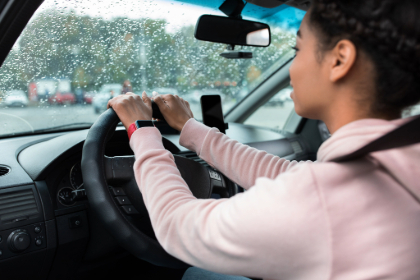INDEPENDENT DEALER
Canada & USA | 416-520-5527
WhatsApp # 1-416-520-5527
OUR BLOG
Rainy roads demand extra care! Learn how to practice safe driving in the rain with must-know tips from Sinwal Enterprises Inc. in Mississauga, ON.

Let’s face it—Ontario’s weather has a mind of its own. One minute, it’s sunny, the next, you’re caught in a downpour that turns the highway into a skating rink. Rain doesn’t just ruin your car’s shine; it makes driving downright dangerous. But don’t worry, we’ve got your back. Whether it’s a light drizzle or a torrential storm, these tips on safe driving in the rain will help you stay in control and confident behind the wheel.
Check Your Tires
Think of your tires as your car’s rain boots. If they’re bald or underinflated, they’ll slip and slide like dress shoes on a wet floor. Worn treads can’t channel water away, increasing the risk of hydroplaning—that terrifying moment when your car glides on water instead of gripping the road. Grab a quarter and check your tread depth; if the caribou’s nose is fully visible, it’s time for new rubber. And don’t forget, cold, rainy weather loves to sneakily drop your tire pressure, so check it monthly.
Protect your engine with top-tier AMSOIL products! Call Sinwal Enterprises Inc in Mississauga, ON, at 416-520-5527 for expert advice and the right oil for your vehicle. Need more supplies? Head to AMSOIL’s online store for everything your car needs!
Keep Your Brakes in Peak Condition
Do you know that awful squealing sound when your brakes protest? That’s their way of begging for attention. Rain makes stopping harder, so if your brakes are already struggling, you’re asking for trouble. Spongy pedals, grinding noises, or longer stopping distances mean it’s time for a brake check. Because when some reckless driver cuts you off on the 401 during a downpour, you’ll want brakes that respond like they mean it.
Replace Worn Windshield Wipers
Ever tried squinting through a streaky windshield while rain hammers down? It’s like driving with fogged-up glasses. Old, brittle wipers just smear water around instead of clearing it. Swap them out every 6–12 months (sooner if they sound like a squeaky shopping cart). And for bonus points, treat your windshield with a rain-repellent—it’ll make water bead up and roll off like magic.
Check and Use Your Headlights and Taillights
Rain transforms daytime into twilight, and if your headlights are off, other drivers might not notice you until it’s too late. Ontario law states that lights must be on in the rain, but don’t just switch them on and forget about them. Burnt-out bulbs or foggy lenses make your car harder to see. Give them a quick wipe and test them regularly—because nobody wants to be the invisible car in a sea of brake lights.
Make every mile count with AMSOIL Signature Series 5W-20 100% Synthetic Motor Oil. Call Sinwal Enterprises Inc in Mississauga, ON, at 416-520-5527 to order now. For added convenience, restock your car care products anytime at AMSOIL’s e-store.
Maximize Visibility with Defrosters and HVAC Settings
There’s nothing worse than your windshield fogging up mid-drive. Before you start wiping it with your sleeve (we’ve all been there), blast the defroster with the A/C on. Yes, even in winter. It pulls moisture out of the air, clearing your view faster than a deep breath on a cold window. And while you’re at it, clean the inside of your glass—those greasy fingerprints love to amplify glare.
Slow Down and Avoid Sudden Movements
Speed limits are for ideal conditions, and rain is anything but ideal. Wet pavement means less grip, and that “just a little faster” mentality can send you hydroplaning into the next lane. Ease off the gas, brake gently, and pretend there’s a fragile wedding cake in your backseat. Sudden moves = bad news.
Maintain a Longer Following Distance
Tailgating in the rain is like playing bumper cars with real consequences. It takes longer to stop when roads are slick, so back off. Use the 5-second rule: Pick a landmark, and if you pass it before you’ve counted to five, you’re too close. And hey, if the guy behind you doesn’t like it? Let them pass. Your safety’s worth more than their impatience.
Know How to Handle Hydroplaning
That floating, weightless feeling when your tires lose contact with the road? Yeah, that’s hydroplaning. Your instinct might be to slam the brakes or jerk the wheel—don’t. Ease off the gas, keep the wheel straight, and let your car slow down naturally. Once you feel the tires grip again, gently steer where you need to go. Panic is the real enemy here.
Final Thoughts
Driving in the rain isn’t about luck—it’s about smart habits. Keep your car in top shape, adjust your driving, and stay alert. Ontario’s roads don’t have to be scary when you’re prepared. So next time the skies open up, take a deep breath, slow down, and remember: you’ve got this.
Stay safe out there—rain or shine!